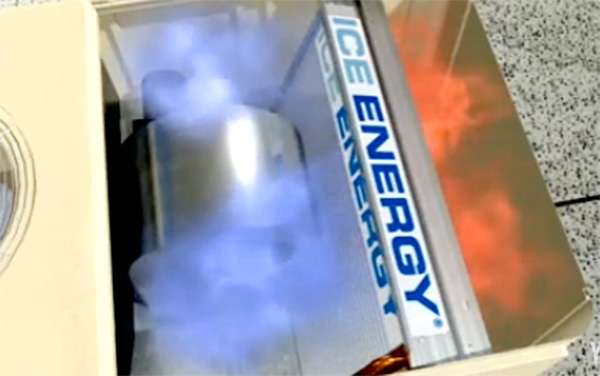Ice Storage
Video
alt="" Discover the Power of Ice IceEnergyIncIce storage systems are an optional feature that can be procured and installed with many chilled water generators. Chilled water generators and their associated pumps provide cool water (actually a water-glycol mixture) via distribution piping to fan coil units installed within individual spaces throughout a building. This system provides conditioned air to a building, but through a distinctly different method than the forced cool air systems that most home-owners are familiar with. Fan coil units, as their name implies, are packaged mechanical devices that use rotating fan blades to push air across sealed coils through which chilled water is being pumped.

Chilled water distribution systems are closed-loop systems and can be more economical for larger building applications than forced-air systems. Fan coil units are placed in series throughout a chilled water distribution loop. After the last fan coil unit in the circuit receives the chilled water being pumped from the generator, return lines carry the (now significantly warmer) water back to the chilled water generator for re-cooling, and the cycle repeats.
A system with ice storage capability can route the return-flow water through ice storage tanks to receive passive re-cooling, instead of through the active operation of the chilled water generator. The stored ice gradually melts as the warmer return-flow water is continually re-cooled in successive cycles. During times of low or non-building occupancy, such as late evening and early morning when cooling is not required, the chiller plant can function in ice-storage mode, creating ice within the storage tanks. This eliminates the costs to operate the chilled water generator for a significant portion of future time, specifically during the hottest hours of the following day’s high occupancy use of the building.
Ice storage systems are considered a “green” technology that is often highly encouraged by the electric utility company serving a particular building location. The reason is that significant demand is experienced by electricity providers in the afternoons of the summer months, when the demand for building cooling is highest. Utility companies are often required to bring additional generators on-line to meet high demands, significantly increasing costs. Ice storage is considered a “peak shaving” technique, because the chilled water generator is making ice during low demand periods throughout the evening, and is dormant during the next day’s peak demand hours. Many utility companies will offer rebates for ice-storage installations. Additionally, for locations with electricity rates that vary throughout the time of day, an ice storage plant could result in much lower overall utility bills for building owners. A cost analysis for each individual situation is required.
The basic components of an ice storage system, in addition to a chilled water generator that has an ice making feature, are manifold piping, more water-glycol mixture, and insulated ice storage tanks. The ice storage tanks are sized to match the ice-making capability (size) of the chiller plant, as well as the volume of required chilled water during the targeted peak-demand hours.

Buildipedia Staff
The Buildipedia research and writing staff consists of dozens of experienced professionals from many sectors of the industry, including architects, designers, contractors, and engineers.
Website: buildipedia.com/